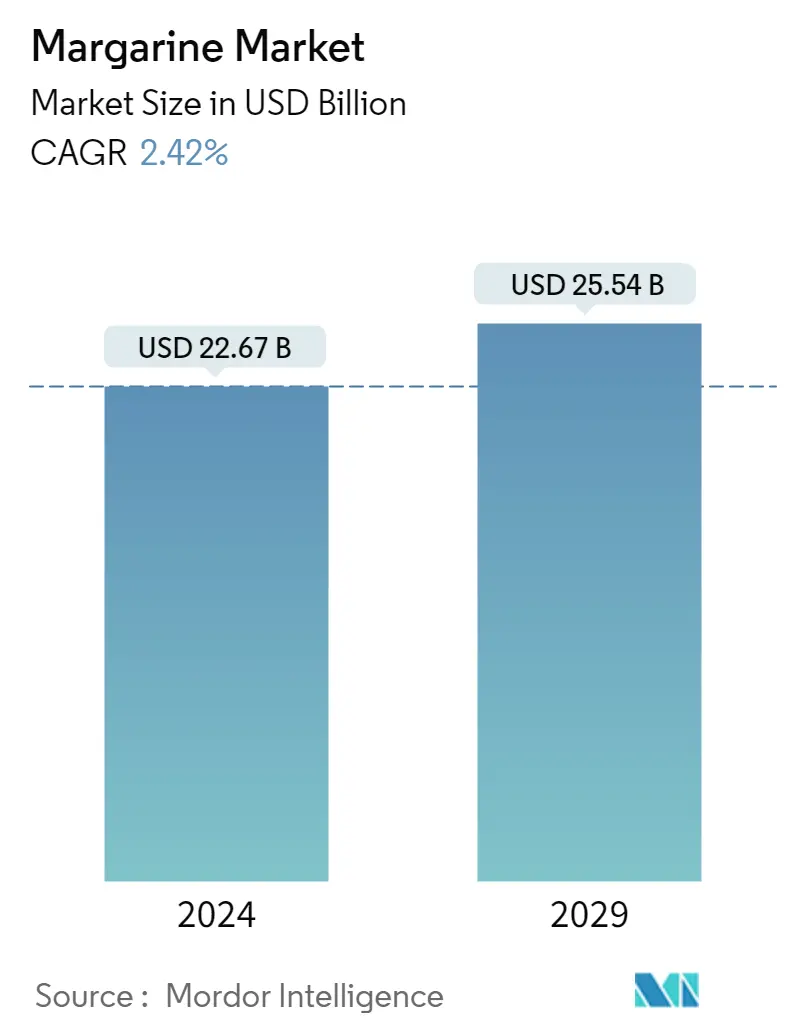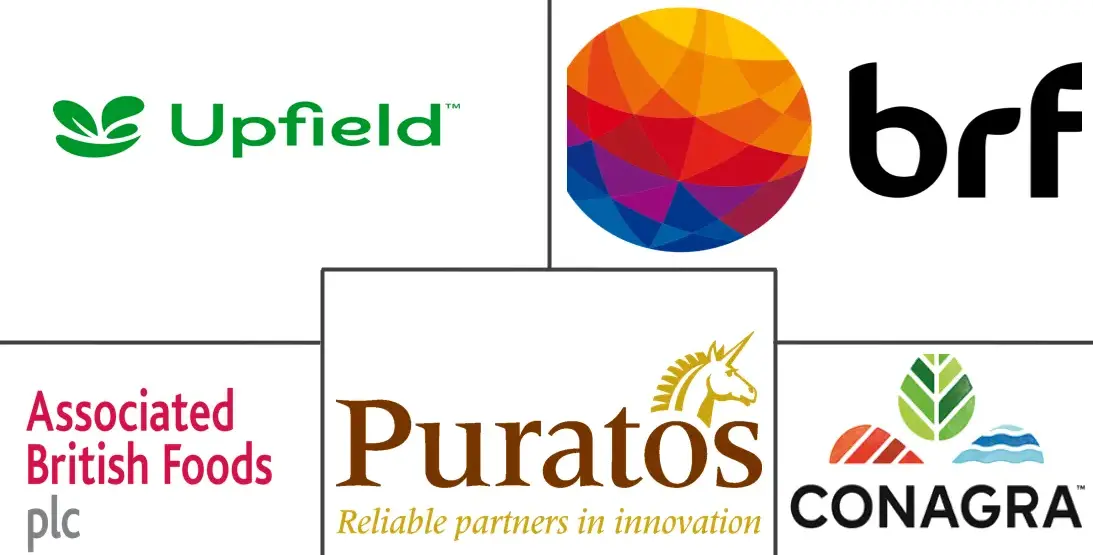Market Size of Margarine Industry

| Study Period | 2019 - 2029 |
| Market Size (2024) | USD 22.67 Billion |
| Market Size (2029) | USD 25.54 Billion |
| CAGR (2024 - 2029) | 2.42 % |
| Fastest Growing Market | South America |
| Largest Market | Europe |
| Market Concentration | Low |
Major Players
*Disclaimer: Major Players sorted in no particular order |
Market Overview
The Margarine Market size is estimated at USD 22.67 billion in 2024, and is expected to reach USD 25.54 billion by 2029, growing at a CAGR of 2.42% during the forecast period (2024-2029).
The product's cost-effectiveness is driving the margarine market as it is increasingly being adopted as a low-cost alternative to butter and other fat-soluble spreads. The use of industrial margarine is reducing the cost of end products. In the bakery industry, margarine is widely being used in products such as pastries, doughnuts, and cookies. Thus, the bakery sector holds a significant role in the application of industrial margarine.
Margarine, made by churning cream or milk, is being adopted as a nutritious alternative to butter. Canola, palm fruit, and soybean oil are a few examples of plant-based oils used to make low-fat margarine. While butter includes saturated fats that harm health, margarine sales have recently increased. Consumers are turning to plant-based butter substitutes to maintain their long-term health, which is anticipated to create new margarine industry prospects. In addition, manufacturers are under pressure to develop suitable solutions to cater to the market and satisfy consumer needs as consumers worldwide are demanding clean labels and sustainable products, which is creating a positive impact on the newly developed margarine products with non-GMO, allergen-free, and other beneficial claims and are anticipated to drive the margarine market.
Scope of the Report
Margarine is a spread manufactured from animal fats and vegetable oil and is generally used as a substitute for butter. The global margarine market is segmented by type, end user, and geography. By type, margarine is segmented into hard, soft and liquid margarine. By end user, the market is segmented into household consumers, HoReCa and industrial. By Geography, the market is segmented into North America, Europe, Asia-Pacific, South America, Middle East & Africa. The market sizing has been done in value terms in USD for all the above mentioned segments.
| Type | |
| Hard | |
| Soft | |
| Liquid |
| End User | ||||||
| ||||||
| HoReCa | ||||||
| Industrial |
| Geography | |||||||||
| |||||||||
| |||||||||
| |||||||||
| |||||||||
|
Margarine Market Size Summary
The margarine market is experiencing a steady growth trajectory, driven by its cost-effectiveness as a substitute for butter and other fat-soluble spreads. This trend is particularly evident in the bakery industry, where margarine is extensively used in products like pastries, doughnuts, and cookies. The shift towards margarine is also fueled by its perception as a healthier alternative to butter, especially with the increasing consumer preference for plant-based oils such as canola, palm fruit, and soybean oil. As consumers become more health-conscious, the demand for margarine that offers clean labels and sustainable attributes is on the rise, prompting manufacturers to innovate and cater to these evolving preferences. This focus on sustainability and health is further supported by government initiatives aimed at reducing trans fats and promoting healthier food options, which is expected to bolster the market's growth.
Europe dominates the global margarine market, with significant consumption driven by the food processing and baking industries. Countries like Germany and France are at the forefront of this demand, with the region's well-developed food processing sector playing a crucial role in the market's expansion. The European Commission's efforts to eliminate trans fatty acids from margarine have led to substantial improvements in product quality, aligning with dietary recommendations and addressing health concerns. The market is characterized by a fragmented landscape with numerous global and regional players, each striving to maintain a strong market presence through diverse product offerings and strategic expansions. Recent developments, such as Vandemoortele's launch of the Gold Cup® margarine range and Wilmar International's investment in new processing facilities, highlight the ongoing innovation and investment in the sector, aiming to meet the growing demand for sustainable and high-quality margarine products.
Margarine Market Size - Table of Contents
-
1. MARKET DYNAMICS
-
1.1 Market Drivers
-
1.1.1 Growing Demand for Bakery and Confectionery Products
-
1.1.2 Increasing Awareness about the benefits of Vegetarian and Vegan Diets
-
-
1.2 Market Restraints
-
1.2.1 Stringent Regulations for Consumption of Trans-Fats
-
-
1.3 Porter's Five Forces Analysis
-
1.3.1 Threat of New Entrants
-
1.3.2 Bargaining Power of Buyers/Consumers
-
1.3.3 Bargaining Power of Suppliers
-
1.3.4 Threat of Substitute Products
-
1.3.5 Intensity of Competitive Rivalry
-
-
-
2. MARKET SEGMENTATION
-
2.1 Type
-
2.1.1 Hard
-
2.1.2 Soft
-
2.1.3 Liquid
-
-
2.2 End User
-
2.2.1 Household Consumers
-
2.2.1.1 Supermarkets/hypermarkets
-
2.2.1.2 Convenience/Grocery Stores
-
2.2.1.3 Online Retail Stores
-
2.2.1.4 Other Distribution Channels
-
-
2.2.2 HoReCa
-
2.2.3 Industrial
-
-
2.3 Geography
-
2.3.1 North America
-
2.3.1.1 United States
-
2.3.1.2 Canada
-
2.3.1.3 Mexico
-
2.3.1.4 Rest of North America
-
-
2.3.2 Europe
-
2.3.2.1 United Kingdom
-
2.3.2.2 Germany
-
2.3.2.3 France
-
2.3.2.4 Russia
-
2.3.2.5 Italy
-
2.3.2.6 Spain
-
2.3.2.7 Rest of Europe
-
-
2.3.3 Asia-Pacific
-
2.3.3.1 India
-
2.3.3.2 China
-
2.3.3.3 Japan
-
2.3.3.4 Australia
-
2.3.3.5 Rest of Asia-Pacific
-
-
2.3.4 South America
-
2.3.4.1 Brazil
-
2.3.4.2 Argentina
-
2.3.4.3 Rest of South America
-
-
2.3.5 Middle-East and Africa
-
2.3.5.1 South Africa
-
2.3.5.2 United Arab Emirates
-
2.3.5.3 Rest of Middle-East and Africa
-
-
-
Margarine Market Size FAQs
How big is the Margarine Market?
The Margarine Market size is expected to reach USD 22.67 billion in 2024 and grow at a CAGR of 2.42% to reach USD 25.54 billion by 2029.
What is the current Margarine Market size?
In 2024, the Margarine Market size is expected to reach USD 22.67 billion.

